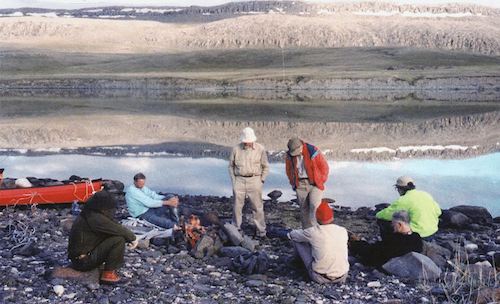A Yankee Notebook
NUMBER 1990
September 9, 2019
Voices of the Earth
EAST MONTPELIER, VT – There are places on this planet where the earth speaks. I suspect there are fewer of them each year, because perhaps they’ve gone silent, or because their voices are drowned out by our noise. The poet Francis Scott speaks of the vast Canadian Shield: Hidden in wonder and snow, or sudden with summer, this land stares at the sun in a huge silence, endlessly repeating something we cannot hear. Inarticulate, arctic, not written on by history, empty as paper, it leans away from the world with songs in its lakes older than love, and lost in the miles. If you’ve ever heard that voice, you’ve been changed for life. You never forget it.
Folks sometimes ask, “Of all the places you’ve been, what’s your favorite?” It’s impossible to answer that question. Each place speaks in a unique voice, and evokes a different response; but in memory, the responses are almost always of reverence and awe.
On our way to the Tetons in 1957, my friend Sam and I stopped in Pinedale and trekked all day through the Bridger Wilderness to the shores of the Titcomb Lakes, high in the Wind River Range of Wyoming. The valley was as nearly perfect a glacial artifact as could be – U-shaped and cliff-sided, with paternoster ponds running away downhill. Our two-man tent was utterly dwarfed by the valley walls, the mountains black and impassive, with clinging snowfields. Golden trout dimpled the surface of the lake. We had a magnificent clear day of climbing the next day, and the following morning packed up and hiked out. Looking back, I remember the otherworldly beauty of the place. But it stood mute, and didn’t speak to me.
Hepburn Island lies at 67 degrees north, athwart the old Northwest Passage. Covered in whispering tundra grass and deserted, it’s cut almost in two by a narrow harbor. From its southern cliffs the north shore of our native continent is visible, a few miles away. Millennia ago there were people here, the Thule. My friend Baird and I, searching, spotted the long-collapsed remains of one of their semi-subterranean houses. A golden eagle watched us from a boulder atop a ridge; the surf beat on the rocks below. It was a spirit place. The vanished people who lived here, unaware of any others, were still watching over it.
For a few months in 1958 I lived in a leanto a couple of miles up Johns Brook, which drains the east slope of Mount Marcy in New York. Today the thickly wooded valley is clogged with hikers, but in that long-gone time it was almost empty. The brook tumbles over boulders its whole course and remains ice-cold into September – my after-work baths were brief – but in its solitude was the sanctuary I needed in the last turbulent days of an overlong adolescence, an untroubled spot in which to begin a new life. It still speaks to me; so I’ve bought a grave plot that gazes up at the mountains enfolding that lovely valley.
A few miles offshore of Ireland’s Dingle Peninsula lie the Blasket Islands, where for centuries a small colony of Gaelic speakers survived by what they could raise, harvest from the sea, or trade for on their forays ashore in their canvas-skinned currachs. They had a hereditary king, resisted the efforts of bailiffs to collect rents (the hated English claimed to own everything) by throwing rocks from the cliffs, burned peat for cooking and heat, and chronicled their lives in several memoirs. They’re all gone now. On a good weather day, you can get out to Great Blasket by excursion boat, land by Zodiac at the foot of the ramp where the poor bailiffs had to dodge rocks, climb the steep path, and wander past the stone walls of the abandoned homes. Walking over the heights where they harvested peat and dug for coneys, or along the White Strand, where they dipped in the sea and, in their heyday, played epic games of hurling, you can feel the embrace of the island and wonder at the islanders’ fortitude. It’s a haunting and haunted place.
Glencoe – where I’ll be this week – nestles between brooding mountains rounded by continental glaciation and decked with hanging valleys and waterfalls. In February 1692 soldiers loyal to King William III (those bloody English again!) who were billeted with the local MacDonalds, massacred as many of their hosts as they could. The survivors fled freezing into the mountains, where they could watch their farmsteads being burned and plundered. For me, at least, the smell of smoke will forever haunt this place.
There have been so many! – the knotted rope of the never-before-canoed Tree River in Nunavut; Bathurst Inlet, basalt cliffs on one side and pink feldspar on the other, where Franklin dawdled in 1821 before his death march across the tundra; Baccalieu Island, Newfoundland (from the Portuguese bacalao for codfish), where a family of tough cookies eked out a living for many years; Leaf River Bay, with the world’s highest tides (higher by inches than even the Bay of Fundy), where we learned to appreciate the vulnerability and resilience of our canoes; Chimney Pond in the cirque of Mount Katahdin, a daunting, but irresistible pile of ice-shattered rock; the Kuujjua on Victoria Island, 71º51’ north, the most beautiful river mouth I’ve ever seen. Ach! Like Lachlan MacLachlan in The Hasty Heart, I’ve shared moments wi’ kings!

Mouth of the Kuujjua

